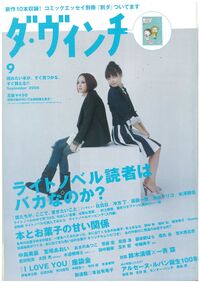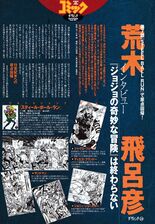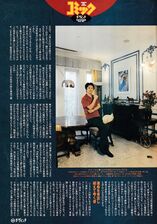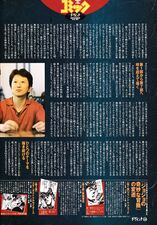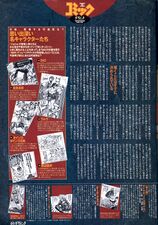Da Vinci (August 2005)
Quarterly S (June 2005)
Interview Archive
An interview with Hirohiko Araki at his house, published in the September 2005 issue of Da Vinci magazine.[1]
Interview
Returning to the starting point with Part 7: Steel Ball Run!
Araki Hirohiko
Interview
JoJo's Bizarre Adventure is not over
Steel Ball Run, Part 7 of the long-running comic JoJo's Bizarre Adventure, which began serialization in Weekly Shonen Jump in 1986 and currently moved to Ultra Jump, continues the story of the JoJo lineage and destiny even today. However, the setting overlaps with the same time period as Part 1, the end of the 19th century. Of course, JoJo, Dio as well as Stand abilities make an appearance. Is this a parallel world, and will we also return to the starting point of their lineage? SBR, which is said to be conscious of the culmination of his hard work, is bursting with dynamic vitality and also appears to rapidly become a masterpiece!
Interview/Text from Akira Odera / Pictures from Munemichi Kawaguchi / © Hirohiko Araki/Shueisha
You probably know that the serialization of JoJo’s Bizarre Adventure (JoJo), which illustrates a bloodline that was enthralled by fate, is still running today. It started serialization from 1986 onwards and was continually written under the title JoJo’s Bizarre Adventure until Part 6: Stone Ocean. However, the JoJo series is now entering a new phase. First off, the title was changed to Steel Ball Run (SBR). Additionally, the period setting has become the end of the 19th century, just like when Part 1 was first serialized. Does this mean that time has come full circle, and that the series starts again from zero after breaking into a parallel world due to the shocking ending of Part 6? Or is this story connected to the story of the Joestar family in a loop? In this new world both JoJo and Dio make an appearance, Zeppeli is a semi-main character (in Part 1, a character named Baron Zeppeli appeared), and deeply familiar names reappear. Furthermore, the serialization moved from Weekly Shonen Jump to the monthly magazine Ultra Jump. It appears as though SBR becomes a break in the JoJo series in various aspects. The family tree which was present in the comic’s opening page has disappeared since SBR, but the story is still a story about JoJo. What does the author Araki Hirohiko have in mind for the new developments in the JoJo series? One thing that we know for certain is his clear determination to not let JoJo come to an end.
In a western-style house that appears as if it materializes the drawn world of JoJo, we began our interview surrounding a marble round table. The owner of the house is just as cheerful and energetic as a young boy. First off, I asked him about what the true intention of once again returning to the setting of the end of the 19th century in Part 7: Steel Ball Run is.
Araki: I had the feeling of wanting to try returning to the starting point. I deliberately kept the stand abilities simple so that the suspense and human drama could be seen clearly. I was also thinking about the readers who hadn’t read JoJo until now. I didn’t want to suddenly bring out a Stand (the visualization of a supernatural power), I wanted to develop them so that they could be understood from the ground up. Maybe the reason why I returned back in time to the end of the 19th century again is meant to be a culmination of my own work. However, in the sense of being a parallel world, fates overlap in this world as well. After all, Johnny Joestar’s rival is Dio, and I draw with such symbolism in mind. People who have read JoJo up to this point will understand this.
In SBR, he illustrated an epic race across the North American continent on horseback. It appears that we return once again to an adventure that overflows with a dynamic wilderness, and it is a work we look forward to the developments of. Mr. Araki said that there is a special emotional attachment to the image of a man on a horse riding through the desert to him, which is depicted in SBR.
Araki: When I was a child, the very first movie my father was taking me along to see was Clint Eastwood’s For a Few Dollars More, which is my starting point. I didn’t get the story at all, but the image of a lonely man riding on a horse in the desert is strongly burned into my mind. I watched it again at the time of drawing SBR, and it has an almost mythical, symbolic composition, doesn’t it?
According to Mr. Araki, the time period of the end of the 19th century was also the era of an extremely special turning point in the history of mankind.
Araki: I have the feeling that it’s an “era of beginnings” comparable to the renaissance era. In the U.S., the telephone was invented and spread with a single swoop. In terms of fine arts, post-impressionism emerged in France, as well as Picasso. In Japan, the Meiji Restauration started. I believe there was a single gigantic stream all over the world. It was also an era of an explosive increase in population. I get the sense that all kinds of things have their roots in that era, and that the fate that humans have inherited from generation to generation were also condensed in that era as “beginnings”.
There are developments as if there would be another big bang, the way the universe contracted, having entirely expanded to its limits. Individual stories center suspense and battle tactics, but when you take an extensive view at the JoJo series as a whole, its grand concept makes you feel like you’re reading the latest cosmology or Indian philosophy.
The fundamental themes of JoJo are “fate” and “destiny”. It seems that by entering a parallel world in SBR, the theme of “destiny” will no longer rise to the surface through bloodlines, but through other aspects from here on out. I asked Mr. Araki about his view on destiny that he attempts to illustrate.
Araki: The theme of JoJo is to accept and face one’s ancestral fate. I wanted to draw people who don’t indecisively curse their own destiny or try to change it, but instead attempt to surpass it.
Whenever I read JoJo, I get the feeling like my spine is straightened when people keep being portrayed who, although seemingly being at the mercy of one’s destiny, affirm it and are prepared for their deaths. Even if they are villains, they all somehow have their own way of living and philosophy, and they have the strong force of will to defy their destiny.
Araki: From today’s psychiatric point of view, the serial killer Yoshikage Kira who appears in Part 4 is probably a victim of abuse from his parents or something similar, and most likely developed such a personality unwillingly. But I don’t want to portray villains in such a way. He is certainly a murderer, but he affirms that about himself and lives after his own theories.
From the viewpoint of strength, Mr. Araki says he feels such characters are stronger and scarier. Mr. Araki illustrates a „strength” that doesn’t stick to simple good and evil.
Araki: Not going into the direction of a spiritual deficit is the basis of shonen manga. For example, I didn’t really like a manga that seemed to dwell on the question on why someone became a cyborg. It’s not exactly refreshing. I thought that it would be better if they got used to and lived with their fate. I wanted to portray that even if there is a fight, it is a fight in which two characters clash and the spirits of both develop higher and higher, step by step.
All the characters that appear in JoJo are fascinating. Speaking of Dio and Yoshikage Kira, the villains also all have their own beliefs and rules they live by. Then, what did Mr. Araki say about his rules when he’s drawing manga?
Araki: The rule in my mind is that it’s all humans, down to the last. They don’t get something like a powerful mecha or a sword to defeat an enemy. They win by their own emotional and physical strength entirely. However, I have little faith in willpower. Even if strength is suddenly brought out and the odds are surprisingly turned around, if there is no theory behind that, it can’t be convincing. Also, there can’t be negative thinking. Both villains and humane people live affirmative to the way of life they follow.
That is the overarching theme of JoJo, “an ode to humanity”. Even if fate can’t be changed, one lives on without being disheartened. The straightforward spirituality one feels in JoJo is probably due to this unwavering theme.
Still, even though I have been reading JoJo since it was first serialized, I never would have imagined that it would continue to a total of 85 volumes. Looking back once more, what does Mr. Araki think about having continued until now? I asked him about the resulting changes from Part 1 to Part 7: Steel Ball Run.
Araki: About how the title of JoJo came around, that’s because at the time, we often used a family restaurant called Jonathan’s for my briefing sessions. At the start, I was conscious of the relationship between grandfather and grandson. At the time, I was greatly moved by the novel East of Eden and the movie The Godfather, and I thought that I wanted to draw such works as well. At the beginning of the serialization, Fist of the North Star and Schwarzenegger movies were popular, and under that influence, the story was about physical pursuits. Part 2 is still an extension of that as well. But while I was drawing physical fights, I came to understand that it was all about the mind and shifted to mental battles.
So from Part 3 onwards, Stands make an appearance, which hold the key to winning or losing in a game of real heart and witful tactics. Owing to the appearance of Stands, it broke free of the macho-like fighting manga formula, and numerous named characters were created which could be called non-physical, like Oingo, Boingo and Rohan Kishibe.
Araki: The truth is, I planned to conclude the series in Part 3, where the connection with Dio spanning three generations would be settled. But because Part 3 had a road trip movie-like story, there were only attack-type Stands, and I wasn’t able to use the idea of a spider-web type of stand. Because I had a lot of ideas left over for such Stands, I established a town as the setting and started on Part 4.
The setting of Part 4 became Morioh, a fictional town. He drew up a detailed town map, down to deciding on the names of the stores, and thoroughly focused on placing the appearing characters as if they really existed in the town. Mr. Araki says that he wanted to depict daily life there.
Araki: Morioh was made in the image of Sendai, the town I was born in, and around the time when I was a child, it was still surrounded by hills and fields. But during the bubble economy of the 1980’s, the hills were cut down and commuter towns were built. I thought things like if it was fine in a religious sense, as temple towns were also torn down. Beautiful houses and mansions were built en masse, but the people who lived there were all strangers, and in the eyes of the residents who lived here since long ago, that was a bit eerie. There were a lot of things like rumors about ghosts coming out. When I hear those stories, I automatically imagine that there’s something behind them, and that became the image of Morioh.
Furthermore, in Part 5, the setting shifts to Italy, where Mr. Araki had travelled more than 15 times, and portrays a group drama of gangsters. In Part 6, the first female protagonist was depicted. Having come this far, one gets wrapped up in the strange feeling as if continuing to draw JoJo is now Mr. Arakis destiny.
Araki: I had no choice but to set Part 6 in the near future of 2011, as around the time of Part 3 being drawn, it already overlapped with the present. I don’t want to draw the distant future. After all, I want the feeling of a present-day car driving around and things like that.
And in SBR, we return once again to the starting point and begin at the end of the 19th century. Making the utmost of the special characteristics of manga which allow for free expression, Mr. Araki even exceeded time.
Araki: I didn’t think that I’d continue until now, but I believe that I’d keep pursuing the themes depicted in JoJo. It feels like destiny, and the time passed so quickly. Whichever author it is, I think they have one or two masterpieces. Even if you’re reading Mr. Osamu Tezuka as a single stream, you get the feeling that a theme continues in all of his works. I am also conscious of the image of manga that seems like a collection of short stories which form a large river.
In the JoJo series, Mr. Araki was first focused on the relationship between grandfather and grandson. This seems to give the impression of Mr. Araki himself having been a “grandfather’s boy”. What kind of boyhood did Mr. Araki have?
Araki: I had two younger twin sisters. Our parents most likely loved us evenly, but my twin sisters woke up at the same time, went to school together, wore the same clothes and so on. That’s why I had the feeling that I alone was left out, and always went to my grandfather’s place to play. There, I came in touch with manga, movies, and art, and my solitude was alleviated. My grandfather made things like models and kites for me, and regardless of what he made, he enjoyed making it.
In such a boyhood, Mr. Araki started drawing manga. Surely, his grandfather who enjoyed making things was an influence. Likewise, the painter Gauguin is one of Mr. Araki’s most influential figures. He was not only influential in his expressions, but also in his way of life.
Araki: When I heard that he lived on a seemingly uninhabited island in Tahiti only for the sake of painting pictures, I received a great shock when it came to my understanding of art until then, and my perception of things changed. I reached the point of looking deeper into the backside. There are people who paint skillfully in many fields too, but knowing Gauguin’s way of life, I also somehow came to think that I wanted to pursue a single thing.
This is what must have led Mr. Araki to continue drawing the single grand story of JoJo. Unless there are dramatic changes, Mr. Araki told us he intends to continue drawing JoJo for as long as he lives.
When Mr. Araki thinks about the story, he says that he begins by meticulously making a map of the city and blueprints for rooms. Aside from that, as far as important characters are concerned, he draws up their personal histories, which include everything to a brief personal record of their parents. Furthermore, if the setting is overseas, he says that before he starts to draw, he actually travels there for research and gets a sense of not only the atmosphere of the city, but also on the location of the streets and the distances between them.
Araki: I want to understand where on the globe the protagonist is. If you don’t know where on earths latitude and longitude they are and what surrounds them, you don’t get to understand in which way the appearing characters will act.
He laughs and talks like that, but I once again feel the depth of JoJo. One is made to feel like the ego of each individual appearing character almost really lives and breathes in that world; that is the charm of JoJo. And Mr. Araki lets me hear an even more interesting story.
Araki: The sculptor Michelangelo said that just by looking at the stone, he already decided on the shape he was going to cut it into. When I heard that story, even though I should be able to carve anything, I felt it was destiny that I could carve nothing but one shape.
Mr. Araki says that he feels the same way even when drawing manga.
Araki: For example, when the protagonist is currently in Aoyama and decides on where to go next, even when he can go to Shinjuku, Tokyo, or Nagoya by train, if you decide on their personality, regardless of the myriad of choices available, it becomes so that they have no other choice but to go to Shinjuku. The author also can’t help it. If you unreasonably try to force the story to go into a more convenient direction, it will become inconsistent and automatically collapse. I feel a sense of destiny there when I draw. I understand the meaning of what Michelangelo said by drawing manga.
Even though you should be able to draw everything, it had already been decided. The strangeness and sublimity of destiny portrayed in JoJo may not even be under the author’s control. This is why one could say that he was able to draw (or was made to draw) a story that stands out to this extent in the history of manga. Mr. Araki draws manga in an extraordinary domain. When Mr. Araki is drawing manga, what time is the most exciting moment?
Araki: After all, the most fun is when I draw something that no one else has done before. This already has no more relation to being popular or some such. I have the feeling that about everyone can pull this off.
I definitely have the premonition that in SBR, something unexpectable is being drawn.
[Translated by Aiku (JoJo's Bizarre Encyclopedia)]
第7部『STEEL BALL RUN』で原点回帰!
荒木 飛呂彦
インタビュー
『ジョジョの奇妙な冒険』は終わらない
1986年から『週刊少年ジャンプ』で連載がはじまった
超大河コミック『ジョジョの奇妙な冒険』の「第7部」
『スティール・ボール・ラン』が、現在『ウルトラジャンプ』に
連載の場を移し、ジョジョの血筋と運命の物語は今も続いている。
しかし、設定が19世紀末と「第1部」と時代が重なっている。
もちろん、ジョジョもディオもスタンド能力も登場する。
これはパラレルワールドなのか、それとも血筋の原点回帰か?
「集大成を意識した」という『SBR』はダイナミックな
躍動感にあふれ早くも大傑作になりそうな予感に満ちている!
取材・文/大寺明 撮影/川口宗道 ©荒木飛呂彦/集英社
運命に魅入られた血筋を描く『ジョジョの奇妙な冒険』(以下『ジョジョ』)の連載が今なお続いていることをご存知だろうか? 1986年から連載がはじまり、第6話『ストーンオーシャン』まで『ジョジョの奇妙な冒険』というタイトルで描き続けられてきた。しかし、ここへ来て『ジョジョ』シリーズは新たな局面を迎えている。
まずタイトルが『スティール・ボール・ラン』(以下『SBR』)となった。そして時代設定が連載開始時の第1部と同じく19世紀末となっているのだ。これは第6部の驚愕のラストでパラレルワールドへ突入したことにより時が一巡し、またゼロから始まった、ということなのだろうか。あるいはこの物語がループ状にジョースター家の物語につながっていくのだろうか。
その新たな世界ではジョジョもディオも登場するし、ツェペリ(第1部ではツェペリ男爵というキャラが登場)が準主役だったりと、馴じみ深い名前が再登場する。そして連載の場が『少年ジャンプ』から月刊誌『ウルトラジャンプ』へと移った。『SBR』はさまざまな面で『ジョジョ』シリーズの区切り目となっているかの観があるのだ。
これまでコミックスの巻頭にあった家系図は『SBR』からはなくなったが、物語は依然、ジョジョの物語となっている。『ジョジョ』シリーズの新たな展開に作者の荒木飛呂彦さんは何を意識しただろう?
ひとつ、確実にわかることは、『ジョジョ』を「終わらせない」という明確な意志である。
まるで『ジョジョ』で描かれる世界観を実体化したかのような西洋風のご自宅で、大理石の円卓を囲みインタビューははじまった。館の主はまるで少年のように快活でエネルギッシュだ。
まず、第7部『SBR』で舞台を再び19世紀末に戻した真意をうかがってみた。
「原点に戻ってみようかな、という感じがあったんです。サスペンスや人間ドラマがはっきり見えるようにスタンド能力もあえてシンプルにしました。これまで『ジョジョ』を読んでなかった読者も意識したいと思ったんです。いきなりスタンド(視覚化された超能力)を出すのではなく、ゼロからでもわかるように展開していきたい。
時代をまた19世紀末に戻したのは、自分の作品への集大成の意味があるのかもしれない。ただし、パラレルワールド的な意味合いでこの世界でも因縁は重なっていて、やはりジョニィ・ジョースターのライバルはディオだったり、そういう象徴的なものは意識して描いています。これまで『ジョジョ』を読んできた人にはわかるようにね」
『SBR』では北米大陸を乗馬で横断する壮大なレースが描かれる。野性味溢れるダイナミックな「冒険」に再び戻った観があり、今後の展開が楽しみになる作品だ。この『SBR』で描かれる砂漠を馬で走る男のイメージは、荒木さんにとって特別な思い入れがあるのだという。
「子どもの頃に父に連れられていちばん最初に観た映画が、クリント・イーストウッドの『夕陽のガンマン』で、僕の原点なんです。ストーリーはぜんぜんわからなかったけど、孤独な男が砂漠で馬に乗っているイメージが強烈に脳裏に焼きついている。『SBR』を描くにあたってあらためて見返したんですけど、神話のような象徴的な描かれ方をしてるんですよね」
また、19世紀末という時代は、人類の歴史の中でも極めて特殊なターニング・ポイントの時代ではないかと荒木さんはいう。
「ルネッサンス時代に匹敵する“はじまりの時代”っていう感じがあるんですよね。アメリカでは電話機が発明されて一挙に普及したり、美術ではフランスで後期印象派やピカソが出てきたり、日本では明治維新が起こったり、世界中に巨大なひとつの流れがあったと思う。人口も爆発的に増えた時代なんです。いろんなもののルーツがその時代にはあって、人間が先祖代々受け継いでいる因縁も、この時代に“はじまり”として凝縮されている気がするんですよね」
まるで限界まで膨張した宇宙が収縮に向かい、再びビッグバンを起こしたかのような展開である。ひとつひとつの物語はサスペンスや戦いのかけ引きが中心だが、『ジョジョ』シリーズ全体を見渡したとき、その壮大な構想は最新宇宙論かインド哲学でも読んでいる気分にさせる。
『ジョジョ』の根底にある「因縁」そして「運命」というテーマ。『SBR』でパラレルワールドに入ったことで、今後この「運命」というテーマが、これまでのように血筋としてではなく、違う様相で浮かび上がってくるように思う。荒木さんの描こうとする「運命観」をうかがった。
「先祖からの因縁を受け入れて、立ち向かうっていうのが『ジョジョ』のテーマなんです。うじうじと自分の運命を呪ったり、運命を変えようとするんじゃなくて、それを超えていこうとする姿を描きたかったんです」
たとえ運命に翻弄されようと、運命を肯定し覚悟する者が描かれ続けてきた『ジョジョ』を読むと、いつも背筋がぴんと伸びるような気分になる。たとえそれが悪役であっても、みな何かしら自分なりの生き方や哲学を持ち、運命に抗する強い精神力を持っていると感じさせるのだ。
「第4部に登場する吉良吉影という殺人鬼なんて、今の精神医学から言うと、たぶん親から虐待とか受けてああいう性格になってしまった被害者なのかもしれない。でも、悪役をそういうふうには描きたくないんです。確かに人殺しなんだけど、そういう自分を肯定して自分なりの理論を持って生きている」
強さ、という観点からすると、そうしたキャラのほうが強く怖いと感じると荒木さんはいう。単純な善悪に捉われない「強さ」を荒木さんは描いているのだ。
「精神的にマイナス方向に行かないのが少年マンガの基本なんです。たとえば、なんでサイボーグになってしまったんだろう……とくよくよするようなマンガはあんまり好きじゃなかった。なんかスカッとしねえなぁっていう。その宿命を利用して生きていけばいいのに、と思ってたんです。闘うにしても、二人が激突して両者の精神が上へ上へとどんどん成長していく闘いを描きたかったんです」
『ジョジョ』に登場するキャラクターたちはみな魅力的だ。ディオや吉良吉影といった悪役もみな自分なりの信念やルールを持って生きている。では、荒木さんがマンガを描く際のルールとはどういったものだろう?
「僕の中のルールはあくまでも人間、なんです。強力なメカや剣を手に入れて敵を倒したりはしない。あくまでも自分の精神力や肉体の力で勝つ。ただし、根性というのはあまり信用してないんです。急に力が出て勝敗をひっくり返すにしても、そこに理論がないと自分で納得できない。あとは、マイナス思考にならないこと。悪役も人間らしい人も自分の生きる道については肯定しているんです」
それが『ジョジョ』最大のテーマ“人間賛歌”なのだろう。たとえ運命が変えられないとしても、そこで挫けずに肯定して生きる。『ジョジョ』に感じる真っ直ぐな精神性は、この揺るぎないテーマがあるからだろう。
それにしても、連載当初から読んできたが、まさか累計85巻まで続くとは想像もしていなかった。あらためて振り返り、ここまで続いたことを荒木さんはどう思われるだろう? 第1部から第7話『SBR』に至る変化を聞いてみた。
「『ジョジョ』というタイトルになったのは、その頃、ファミレスのジョナサンをよく打ち合わせに使っていたからなんです。最初はお爺さんと孫という関係を意識してましたね。その頃、小説の『エデンの東』や映画の『ゴッドファーザー』にすごい感動して、自分もそういう作品を描きたいと思ったんです。
連載当初は『北斗の拳』やシュワルツネッガーの映画が流行っていて、その影響で肉体追求の話だった。第2部もまだその延長です。でも、肉体的な闘いを描いていくうちに、心なんだな、とわかってきて、精神的な闘いに移っていったんです」
そして、第3部からは本格的に精神と知恵の駆け引きが勝負の鍵を握る「スタンド」が登場する。このスタンドの登場により、マッチョな格闘マンガの図式を抜け出し、オインゴ・ボインゴや岸辺露伴といった非肉体的とでも言うべき数々の名キャラクターが生み出されていった。
「三代にわたるディオとの因縁に決着がつく第3部で実は完結するつもりだったんです。でも、第3部はロードムービーのような物語だったので、襲ってくるタイプのスタンドばかりで、蜘蛛の巣のように持つタイプのスタンドのアイデアが使えなかったんです。そういうスタンドのアイデアがいっぱい余っていたので、設定を街ということにして第4部をはじめたんです」
第4部では架空の街・杜王町が舞台となる。綿密な街の地図を作成し、店の名前まで決め、登場キャラが街に実在するかのように徹底して配置にこだわったという。そこに「日常」を描きたかったと荒木さんはいう。
「杜王町は僕の生まれた仙台をイメージしているんですが、僕が子どもの頃はまだ野山に囲まれていた。でも、80年代のバブル期に山が切り崩されてベッドタウンができてきたんです。寺町が潰されたりもしていて、宗教上いいのかな、と思ったりしましたね。奇麗な家やマンションがいっぱい建ってるんですけど、住んでる人たちは全員よそ者で、昔からの住人から見ると、ちょっと不気味だったんです。幽霊が出る噂がいっぱいあったりする。そういう話を聞くと、裏に何かあるのかなと想像しちゃって、それが杜王町のイメージになってるんです」
そして第5部では舞台を荒木さんが15回以上も旅行したというイタリアに移し、ギャングたちの集団劇を描き、第6部では初の女性主人公を描いていった。ここまでくると、もはや『ジョジョ』を描き続けることが荒木さんの運命であったかのような奇妙な感慨に包まれる。
「第6部で時代設定が2011年という近未来になったのは、第3部を描いていた頃がもう現代と重なってましたから、もうしょうがなかったですね。超未来は描きたくないんです。やっぱり現代の自動車とかが走っている感じが欲しいんです」
そして『SBR』は再び原点に戻り19世紀末からスタート。自在な表現が許されるマンガの特性を最大限に生かし、荒木さんは時間すら超えてしまった。
「ここまで続くとは自分でも思ってなかったけど、『ジョジョ』で描いているテーマは追っていくだろうな、とは思ってました。運命を感じるし、あっという間でした。どんな作家でも代表作は一つか二つだと思うんです。手塚治虫先生でもひとつの流れとして読むと、すべての作品のテーマが続いている感じがする。短編小説が集まって大きな河になっているようなイメージのマンガを僕も意識しています」
『ジョジョ』シリーズで荒木さんが最初にこだわった「祖父と孫」という関係。それは荒木さん自身が「お爺ちゃん子だった」という影響があるらしい。どんな少年時代だったのだろうか?
「妹が双子なんです。親の愛情は平等なのかもしれないけど、双子って同じ時間に起きて学校に行って、同じ服を着たりしてるわけだから、どうしても自分だけが離れている感じがあって、お爺ちゃんの所にばかり遊びに行ってたんです。そこでマンガや映画や芸術に触れて孤独を癒されたんですよね。お爺ちゃんは模型を作ってくれたり凧を作ってくれたり、何かを作ることがとにかく好きな人でしたね」
そうした少年時代に荒木さんはマンガを描きはじめた。きっと作ることが好きなお爺ちゃんの影響があったのだろう。また、荒木さんがもっとも影響を受けた人物に画家のゴーギャンがいる。それは表現のみならず、生き方にも影響を与えた。
「絵を描くためだけにタヒチの無人島みたいな所で暮らすというのを聞いたとき、そこまで芸術って凄いのかって衝撃を受けて、物事の捉え方が変わったんです。より深く裏側まで見るようになった。器用にいろんな分野を描く人もいますけど、ゴーギャンの生き方を知って、僕も何かひとつのことを追っていきたい、と思うようになった」
それが荒木さんにとって『ジョジョ』というひとつの長大な物語を描き続けることにつながっていったのだろう。劇的な変化がない限り、荒木さんは『ジョジョ』を生涯描き続けていくつもりだと話してくれた。
荒木さんがストーリーを考える際、街の地図や部屋の見取り図を綿密に作ることからはじめるという。さらに重要なキャラクターに関しては親の略歴まで含む履歴書を作成する。さらに舞台が海外であれば実際に取材旅行をし、街の雰囲気だけでなく道の位置や距離感まで把握してから描きはじめるという。
「主人公が地球のどこにいるのかわかっていたいんです。地球の緯度経度のどこらへんにいて、周りに何があるのかをわかってないと、登場人物がどういうふうに行動するのか、わからなくなるんですよね」
そう笑って話すが、『ジョジョ』の奥深さをあらためて感じる。あたかも本当にその世界で息をしているように登場人物個々の自我まで感じさせてしまうのが『ジョジョ』の魅力である。そして荒木さんはさらに面白い話を聞かせてくれた。
「彫刻家のミケランジェロが、石を見ただけですでに削る形は決まっているって話しているんです。その話を聞いて、なんでも彫れるはずなのに、その形しか彫れないというのは、運命だと感じたんですよね」 マンガを描いていても同じことを荒木さんは感じるという。
「たとえば主人公が今青山にいて次にどこへ行こうかってなったとき、電車で新宿にも東京にも名古屋にも行けるのに、性格を決めると選択肢が無数にあるにもかかわらず新宿にしか行かなくなるんです。作者にもどうしようもない。無理にストーリー上都合のいいほうに持っていこうとすると、辻褄が合わなくなって破綻してしまう。描いていてそこに運命を感じる。ミケランジェロの言っている意味がマンガを描いていてわかるんです」
なんでも描けるはずなのにすでに決まっている。『ジョジョ』に描かれる運命の奇妙さ、崇高さとは、作者にすらコントロールしかねるものなのかもしれない。だからこれだけマンガ史の中でも突出した物語を描けた(描かされた)、という言い方もできるのではないだろうか。とてつもない領域で荒木さんはマンガを描いている。そんな荒木さんがマンガを描いていて、もっとも盛り上がる瞬間とはどんなときなのだろう?
「やっぱり誰もやったことがないことを描くときがいちばん楽しい。もうそれは人気とか関係ないんです。みんな引いてもいいくらいの感じなんです」
何かとんでもないものが描かれつつあるという予感が『SBR』には、たしかにある。
